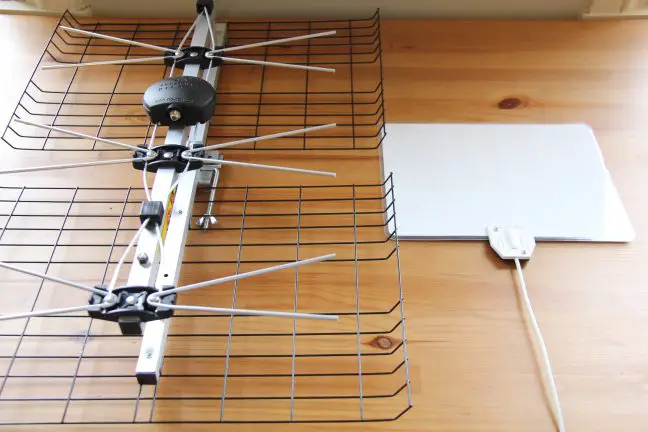The Leaf is a revolutionary antenna that is almost paper thin and tiny compared to a metal antenna. To give you an idea, Here is a photo of the the big DB4 metal antenna next to the Mohu Leaf on the right:

The Mohu antenna itself is just a little larger than a sheet of paper, at 11″ x 9″ and feels like thin plastic (the one shown above is an older version that feels like laminated cardstock; the new version is more sturdy plastic). The connector area is a about 3/8″ thick. It is white on one side and black on the other. I also have their powered version called the Leaf 50 which looks exactly the same except that it has a power cable and a built-in amplifier, which is hidden inside the connector area.
Testing the Leaf
I was eager to put the Leaf 30 and Leaf 50 through their paces. How could these compete with a big bulky antenna many times its size?
I picked four different locations in my apartment to give a variety of results under different signal conditions. Here are the number of channels that each antenna “found” in each of the four locations (a bigger number is better!):
| Location | Rabbit Ear | DB4 | Mohu Leaf | Amplified Leaf |
|---|---|---|---|---|
| Location #1 | 16 | 30 | 29 | 32 |
| Location #2 | 4 | 5 | 18 | 11 |
| Location #3 | 8 | 10 | 10 | 10 |
| Location #4 | 17 | 16 | 28 | 30 |
As you can see, there is quite a variation in performance based on signal conditions. In locations 1 and 3, the three antennas performed about the same. Although the Mohu Leaf 50 “won” in two locations, statistically these can be considered a tie.
I was blown away that the thin Mohu Leaf 30 found more channels on average than a bulky metal antenna! How could that be? Well, in Providence, RI, where I did this test, the TV signals come from almost all directions. The DB4 is good at receiving signals from only a narrow angle. It has a reflector in the back which blocks signals from that direction. The Mohu Leaf, on the other hand, is better at getting signals from all directions.
You might also be wondering why the unamplified Mohu Leaf beat the amplified Mohu Leaf 50 so handily in location #2. In general, when the antenna is indoor and the cable run to the antenna is short, amplification doesn’t give much benefit. In fact, if strong TV signals are present, a powered antenna can actually over-amplify the signal and distort the weaker channels which are part of the same signal. Here is an article describing why an indoor powered antenna is often no better than a passive one. I confirmed these conclusions with an antenna engineer that I talked to. Also, if you read reviews online, you’ll see that many people see no improvement with an amplified indoor antenna.
I also tried a cheap rabbit ear antenna and confirmed that it was the worst. Steer clear of rabbit-ear antennas or any kind of antennas with telescoping arms. They are a pain to adjust and give poor reception.
The Winner
So, to sum up, I would recommend the regular Mohu Leaf 30 for most people who live in areas with moderate to strong TV signals. If your antenna is going to be far from your TV, or if you want to drive multiple TV’s, or if you live really far from all stations, go with the amplified Leaf 50. If you are just using your antenna with one TV, go with the regular Leaf 30. It’s just as good (or better) for a lot less money. I personally have both, and I use the regular Mohu Leaf 30 while my Amplified Mohu Leaf 50 sits unused. Save your money!!
Before buying anything though, please enter your zip code into the Station Finder to make sure there are channels in your area. If you live in a big city, you should be fine. If you live in a rural area, there might not be broadcast channels available.
The Mohu Leaf costs significantly less than the DB-4 antenna, making the Mohu Leaf the winner when it comes to value! Check the Mohu Leaf Paper-Thin Indoor Antenna out on Amazon here:
Disclosure: Some of the links on this page are affiliate links. This means if you click on the link and purchase the item, I will receive an affiliate commission at no extra cost to you. I test or research each product or service before endorsing. This site is not owned by any retailer or manufacturer. I own this site and the opinions expressed here are mine. As an Amazon Associate, I earn from qualifying purchases.
The Leaf is made in the U.S.A., which I really like!
Note the Leaf has a black side and a white side. It doesn’t matter which side you point toward the TV transmission towers.
One Caveat…
Although the Mohu Leaf antenna is great, the cable that comes with it isn’t. If you get the Mohu Leaf, I recommend also purchasing a high-quality RG6 coax cable of the appropriate length for your home. It really makes a difference in getting the most channels:
Conclusion
For me, the Leaf is the winner. I have packed away my DB4 and am using the much less obtrusive Leaf now. The Mohu Leaf is my favorite indoor antenna!! – Brian


Brian, I also learned about the noise boosting of amplified antennas. As to the MOHU LEAF (btw BestBuy seems to only carry the amplified variety), there is one thing I think you didn’t mention: is it directional or multidirectional? I learned that “more,’ just like “amplified,” “multidirectional” is not necessarily better. Why? Because you can easily tweak a directional antenna to get any station in your vicinity. With a multidirectional antenna, you do not have the option of “tweaking” — reception is what it is. No possibility of improvement.
Hi Wolf,
Yes very good points! I would say the most accurate way to describe the Mohu Leav is “bidirectional”. It works best when the flat surface is pointed at the tower, although it will work in other directions, just not as well.
Best,
Brian
Which side of the Mleaf antenna should be facing outside?
It doesn’t matter. The actual antenna is in the center of the plastic “sandwich”.
Best,
Brian
Can you connect other Smart TVs wirelessly?
Hi David,
In order to do watch broadcast TV on multiple TVs using one antenna, you could use a DVR such as the Tablo or Air TV. More here:
https://www.disablemycable.com/dvr/
Best,
Brian
Thanks!
Is it possible that the area I live in does not have signal to use an antenna? Is there a way that I can check based on zip code?
Hi Whit, yes absolutely! Enter your zip code into the Station Finder:
https://www.disablemycable.com/station-finder/
Best,
Brian
I read your article with much interest. I am happy enough with the stations I pick up living in Providence with my antenna. Last night the Patriots game was only on the NFL Network and local TV in Boston. I generally don’t pick up Boston stations which are 35 to 40 miles away. For some reason I decided to look up the digital number for WBZ, plug the number into my TV and was astonished to find the Patriot game was on. Now without even reprogramming my TV, WBZ is automatically on it now. I guess my question is how come I can’t pick up other Boston stations whose towers aren’t that much further and seem to be putting out the same signal as WBZ. If you still live in Providence are you able to pick up Boston stations with your Mohu Leaf 30 ? Thanks
Hi Antwan,
Thanks for sharing! I don’t live in Providence anymore, but when I did, I was indeed able to pick up some Boston stations with my Mohu Leaf.
Reception depends on many factors including distance and transmission power as you said. But another big factor is what frequency they transmit on. Generally, the higher frequencies (UHF) are easier to pick up using the Leaf than the lower ones (VHF). Another factor is electronic interference. Finally, there could be an obstacle between you and the other towers.
But, keep experimenting! You never know what you’ll be able to get. Congrats on getting the Patriots game!
Best,
Brian
I’m a little surprised that RG-6 helps over RG-59, over very short runs. Usually RG-6 is better for low loss over very long runs.
I used your test tip with RG-59 and a pair of aligator wired clips to the electrical cord on a lasko fan sitting on the floor of my 2nd floor apt. to find over 70 channels.
Wondering if the un-amped Leaf would improve this? I doubt after this test above that I would need a amped version -that may only over-amp, or amp noise too and be worse.
With your EE background, maybe do a test of how to MAKE your own simple multi-directional antenna?
Speaking of multi-directional antennas, I find it hard to get this detail explicitly advertised for many amazon antennas.
Hi,
Based on getting 70 channels, I think an un-amped Leaf would be better than amped.
Yeah, it’s hard to make a truly multi-directional antenna that’s really good. If I find one, I’ll let you know.
Thanks,
Brian
i wonder why we need to pay for cable tv shows when the tv shows are aired free..
what kind of antenna does these cable tv suppliers use that ordinary people can’t use?
where can we buy those antennaes?
Hi Jim,
Unfortunately, many of the channels on cable TV other than the networks and local stations are not broadcast to the masses. There’s no way to get those using an antenna.
There are, however, some great free streaming services that you can watch using a Roku or smart TV:
https://www.disablemycable.com/streaming-services/
Best,
Brian
I think this was about broadcast channels over cable, for which my spectrum provider surcharges $18/mo.
This should be illegal. We should not have to pay extra for these over cable, especially if we do not want or watch them. At one time I recall you could get just these free (per FCC regs) over the local cable provider if your location was in a map dead zone for over the air signals.
Hi,
Thanks for sharing – agreed!
Brian
Hi Brian – this may sound like a dumb question, but I am pretty dumb when it comes to this kind of stuff! lol. Do I need a Leaf for each TV in my house? Or will all four TVs run off one Leaf?
Hi Tina,
That is not a dumb question! In fact, that is one of the most common questions I get! I wrote a whole article to answer it:
https://www.disablemycable.com/blog/need-separate-antenna-tv/
Hope this helps,
Brian